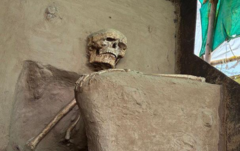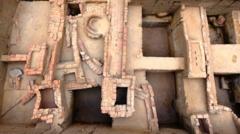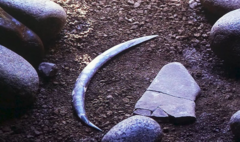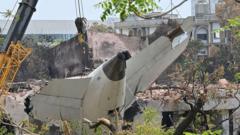The fascinating discovery of a cross-legged skeleton in Vadnagar, Gujarat, has yet to secure a place in a museum due to ongoing administrative disagreements. Although highly significant for historical understanding, the skeleton has been housed in a makeshift shelter for six years, drawing local concern and highlighting issues within the archaeological bureaucracy.
Ancient Skeleton's Quest for a Museum: A 1,000-Year-Old Legacy in Limbo

Ancient Skeleton's Quest for a Museum: A 1,000-Year-Old Legacy in Limbo
A significant 1,000-year-old skeleton discovered in Gujarat, India, remains without a permanent home, embroiled in bureaucratic disputes six years after its unearthing.
A 1,000-year-old skeleton, discovered in Gujarat, India, continues to await a proper museum home, six years after its archaeological significance was recognized. The skeleton, unearthed by archaeologist Abhijit Ambekar in Vadnagar in 2019, was found sitting cross-legged, reminiscent of meditative practices, and is believed to date back to the Solanki period, which spanned from 940 to 1300 CE.
Ever since its discovery, the skeleton has resided in a makeshift tent instead of being showcased in a museum, due to bureaucratic disputes over which governmental body should take charge. Abhijit Ambekar, who heads the Archaeological Survey of India (ASI) division in Mumbai, asserts that the skeleton is crucial for understanding the region's ancient heritage.
The Gujarat government has indicated that while many artefacts from Vadnagar have been transferred to local museums, the skeleton's delayed placement stems from procedural oversights. Pankaj Sharma, the director of the state’s Directorate of Archaeology and Museums, noted that proper protocols were not followed in the skeleton's case, affecting its timely transfer to a museum.
Currently, the skeleton is sheltered under tarpaulin, exposed to the elements and without protective security. Locals have become increasingly vocal, including residents such as Jesang Thakor, who expressed disappointment at the treatment of such a significant artefact while M Thennarasan, the principal secretary of the state’s Cultural Activities Department, reassured that efforts are being made to find a suitable museum for it.
Just nearby is the new Archaeological Experiential Museum, inaugurated with an impressive budget of $35 million, which prominently features a photo of the skeleton, yet does not include the actual remains. The government had aimed to place a plethora of historical findings—including nearly 9,000 artefacts—into local institutions, but this key discovery remains in limbo.
Ambekar further elaborated on the skeletal remains’ potential insights into "samadhi burials," an ancient Hindu custom. The skeleton, which survived due to unique soil conditions, may offer valuable data concerning the individual's lifestyle and dietary habits. Stratigraphic studies affirm the skeleton's local ancestry and age, shedding light on Vadnagar's cultural evolution.
Despite the archaeological significance of this skeleton, the continuing delay due to bureaucratic red tape illustrates challenges within India's heritage preservation efforts, as local pride in Vadnagar's history clashes with administrative inefficiencies. The community hopes that this unique discovery will soon be properly acknowledged, highlighting the need for effective governance in safeguarding cultural artifacts.






















